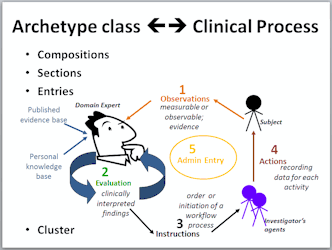Pregnancy Care Record approachPregnancy Care Record approachPregnancy Care Record approach
...
The Northern Territory approach to the creation of an electronic Pregnancy Health Record is to use clinically-agreed archetypes as the basis for an Antenatal software development.
...
There are four main types (or classes) of archetypes that are useful to understand – each corresponding to classes in the openEHR Reference Model and each has particular attributes that correspond to clinical processes.
1. Compositions – which correspond to commonly used clinical documents, such as 'antenatal visit' or 'care plan'. (Think of these as the equivalent to the blank piece of paper in a current paper record, before you start to write.)
2. Sections – these are effectively used to assist with human navigation within EHRs and correspond to document headings, for example 'antenatal examination' or 'summary'. (Think of these as the headings that provide a framework for writing on a blank piece of paper.)
...
4. Clusters – think of these as re-usable fragments of clinical information. They do not 'stand-alone' within a health record but provide a way to re-use a common clinical data patterns within many of the Entry archetypes. Examples include: dimension; anatomical location; change; and specimen.
Process
Candidate archetypes have been developed to represent the wide range of clinical concepts that are used in an Antenatal Health Record.
Content for each of these archetypes have drawn heavily from existing resources such as the NT Antenatal Health Record, the Queensland Antenatal Health Record, the national HandHeld antenatal record and international resources. Sometimes the content alignment with the existing resources is easily recognisable; sometimes it may appear a little different. This is because in all situations the data needs to be represented so that it can be re-used in many different potential activities and scenarios, including safe and sensible clinical decision support.
The existing resources have been analysed and the discrete clinical concepts that contribute to the whole document have been identified.
For example: 27 concepts have been identified within the current NT Antenatal Record.
Insert thumbnails – antenatal_record1.jpg, antenatal_record2.jpg, antenatal_record3.jpg, antenatal_record4.jpg
Each clinical concept is represented as a separate archetype, and each of these archetypes have been uploaded to an online tool, known as the Clinical Knowledge Manager (CKM), which is hosted by NEHTA.
Within the CKM each archetype will undergo review rounds by a range of clinicians, terminologists, software engineers, informaticians and other interested experts. The purpose of each review round will be to fine-tune each archetype so that it meets the requirements for each stakeholder group.
For the clinicians we seek to ensure that all relevant date elements are included, that the names and descriptions are correct etc – the end goal being that the archetype at the end of all review rounds is regarded as safe and 'fit for clinical purpose'. Any and all contributions are gratefully received from all reviewers, ranging from simple typo and grammar corrections, through wordsmithing descriptions, to challenges about incorrect or missing content.
Similarly terminologists, vendors, informaticians will all contribute according to their expertise, intending that the archetype is also fit for their purpose.
The aim is to collaboratively build a data pattern for a single clinical content that meets all stakeholder requirements.
Reviewers will receive email invitations to participate in the online review, which will usually be open for comment for a period of a few weeks. After each review round, Editors will review all comments from all reviewers, provide feedback to reviewers, update the archetype and initiate another review round.
Review rounds will continue until consensus has been achieved – surprisingly, in experience to date, the inclusive nature of the maximal data set has enabled consensus on the structure of the archetypes. If consensus is not achieved, then it will need a resolution process will allow for publication of the agreed parts of the model, allowing for further research and discussion and potential future revision of the archetype.
Analysis
Decision Support
Possible functions:
...
